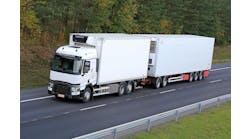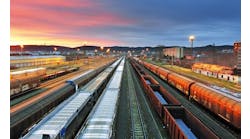The American Transportation Research Institute’s (ATRI) annual survey of fleet owners about what were the previous year’s operational costs for trucking usually yields valuable data to help logisticians plan their supply chain management strategy. This year, however, things are a bit different.
In 2019 the industry suffered from a decline in freight shipments. Early this year after the COVID-19 pandemic hit, it became immediately obvious that the industry long considered the nation’s most vital transportation mode would face the opposite of a freight drought with skyrocketing need for distribution of food and medical supplies throughout the country.
In spite of the survey’s backward-looking approach, the institute says the findings are still useful for informing forward-looking strategy. In fact, they say the ATRI cost analysis also offers useful data to lay the foundation for transportation planning in the long run.
“Given the chaos and volatility of freight markets these days, it is more critical than ever that trucking fleets closely monitor their cost centers,” says Brandon Knight, principal of transportation for the CliftonLarsonAllen accounting and management consulting firm. “ATRI’s Operational Costs report is an important benchmarking tool for fleets of all sizes and sectors.”
The report was written by Dan Murray, senior vice president, and Nathan Williams, research analyst, with ATRI. The data was collected between May through the end of September from a diverse group of for-hire trucking executives. ATRI also gathered data from the National Private Truck Council, which produces a similar annual benchmarking report about private fleets. Additional information was drawn from news alerts and coverage from industry trade press.
While the first half of 2019 rode in on the coattails of an unparalleled year of economic growth in 2018, the latter half of 2019 softened economically, Murray and Williams note. “Many economists described the last two quarters as recessionary. The overall outcome was considerable volatility in trucking operations and the requisite costs.”
The economic softening, combined with a number of independent factors including lower fuel prices, decreased the marginal cost of trucking, the institute found.
The average marginal cost per mile incurred by truckers in 2019 decreased 9.3% to $1.65. The line-item costs for almost every major line item experienced some level of decrease. In comparison to the last freight softening, which took place in 2016, marginal costs were still six cents higher, indicating the persistence of generally higher costs.
Among the line items seeing a decline in these kinds of costs in 2019 were truck/trailer lease or purchase payments (-2%), permits and licenses (-5%), repair and maintenance (-16%), and tires (-5%). Not surprising to anyone traveling on urban highways, tolls were one of the few costs to rise, jumping 15%.
Also seeing their first declines in many years were driver wages and benefits costs, which were down from 77.6 cents per mile in 2018 to 69.3 cents per mile, which was a counterintuitive decrease given the driver shortage, the researchers say. However, bonuses for drivers universally increased, with retention bonuses showing increases of more than 80%, they observe. The average starting bonus also rose from $1,562 in 2018 to $1,846 in 2019—representing an increase of 18%.
“While the cost per mile for total driver compensation fell, carriers are clearly addressing the driver shortage through other mechanisms,” Murray and Williams say. “Even with freight demand softening in 2019, the driver shortage continued to persist throughout the year, and is expected to worsen in the coming decade.” Current projections have the shortage topping 160,000 drivers by 2028.
Most notably, safety bonuses also increased 11% from 2018 to 2019, from an average of $1,238 to $1,373. “Companies are incentivized to invest in safety, as large verdicts due to crashes have been increasing over time and putting strain on businesses,” ATRI explains. This average safety bonus amount is the highest in the last three years and is seen as an attempt to combat an increase in large truck crashes by offering larger incentives to the safest drivers.
Surprise Insurance Drop
A decline in insurance costs caused the biggest surprise. Truck insurance premiums had increased nearly every year since 2012, with some years experiencing double-digit increases, but 2019 saw a 1.6-cent-per-mile drop from the previous year.
“While a small decrease in ‘truck miles traveled’ occurred—a key denominator in calculating exposure and risk—the market situation relating to insurance losses and excessive litigation generated a high expectation for another costly year in insurance,” Murray and Williams report.
“After mining the data and reviewing it with insurance industry experts, the conclusion was clear: Trucking fleets are maxed out on their ability to absorb another year of higher insurance premiums, and have responded by dramatically increasing deductibles, reducing excess insurance coverage and moving to ‘captive insurance programs,’” they add. “While these short-term approaches to manage cost increases appear to be stabilizing insurance costs, the long-term result is a potentially catastrophic increase in accrued carrier risk.”
ATRI’s research primarily deals with for-hire fleets, but the researchers consider it applicable to private fleets, defined as a trucking operation in support of a non-trucking operation, like those owned by Walmart and Tysons Foods, sometimes including trucks operated by third-party logistics providers (3PLs).
“Looking forward, 2020 data will certainly reflect the most impactful year of social, medical and economic change seen in many generations,” Murray and Williams say. “Until a full year of 2020 data is collected and analyzed, only anecdotal analyses are available. Given the increasing freight demand and the pressures of the driver shortage, it is likely that driver wages in 2020 will increase.”
Shelter-at-home policies and other economic factors that pre-date the COVID-19 pandemic have kept fuel costs down and are expected to continue to do so in 2021, ATRI’s researchers believe.
In 2019, fuel costs per mile were 39.6 cents per mile, decreasing from 43.3 cents per mile the previous year. Dropping almost 9% from 2018 to 2019, most of the fuel cost decrease can be attributed to substantially lower diesel costs in 2019.
The institute’s 2020 report also includes a targeted analysis titled, “Driving the Trucking Industry: Small Carrier Spotlight,” which compares fleets of 100 or fewer trucks to fleets with more than 100 trucks.
“Over the last several years, most cost centers in trucking have been higher among owner-operators and small fleets, leading to speculation that small fleet capacity would be absorbed by larger fleets—driving many thousands of firms out of business,” the researchers note. In addition, small fleets pay more in fuel, tires and insurance because they lack the buying power of larger fleets.
In reality, the opposite phenomenon has come true, ATRI found. Small fleet registrations are up considerably over the last few years, and these fleets are seeing meaningful growth. Industry experts speculate that higher small-fleet costs are being mitigated by their ability to be more responsive, dynamic and customer service-oriented.
ATRI points out that small fleets are also able to pay slightly lower driver wages, and still experience considerably lower truck driver turnover. Finally, small fleets are heavily reliant on spot-market rates, which have generally been favorable over the last several years of solid growth and tight capacity. The institute believes those conditions can be expected to return in 2021.
Overall, the trucking industry’s ability to respond quickly to long-term economic trends, such as e-commerce growth, favors an increase in the industry’s market share, the researchers predict. In addition, trucking is seen as resilient in short-term downturns as seen in late 2019, and responsive in times of crisis, such as the COVID-19 pandemic.
“Overall, the trucking industry’s economic health, while tied to many externalities including national policy shifts, appears to be strong far into the future,” Murray and Williams assert.




